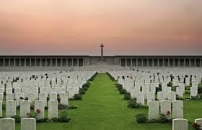| First Name: | Henry | Last Name: | WARE | |
|---|---|---|---|---|
| Date of Death: | 21/03/1918 | Lived/Born In: | Nunhead | |
| Rank: | Rifleman | Unit: | Rifle Brigade8 | |
| Memorial Site: | Pozieres Memorial, France | |||
Current Information:Born-Nunhead
With an end to the fighting on the Eastern Front after the Russian Revolution, Germany was able to bring its troops from there to France and launch a series of offensives in the Spring of 1918, designed to bring the war to a swift conclusion. Four times between March and July they attacked in strength and on each occasion they broke through the British and French lines and made spectacular gains but in each case they over extended themselves and without adequate supplies keeping up with their rapid advances, they could go no further. The first of these attacks, Operation Michael, was made on 21st March by 63 specially trained divisions, attacking along a 60 mile front held by 26 British divisions, many of them in a weakened state At 4.40am the German artillery opened up with the most ferocious and concentrated bombardment of the war, the likes of which the British had never experienced before. The Forward Zone, consisting mainly of individual posts was blown away. Very few of the men there made it back. Many were killed and many more were taken prisoner. The Battle Zone was also battered as were the British guns, firing from positions just to the rear. Brigade and Divisional HQs were targeted as well and then, from out of the thick mist came the German storm troopers. Moving fast, they skirted round the few remaining strongholds and penetrated deep into the British lines, including those of the Battle Zone, causing the utmost confusion. There were many cases of heroic stands being made but the relentless pressure forced the British back everywhere and there then began a general retreat that went on for two weeks and which ceded to the Germans a huge amount of territory, including all of that that had been won at such great cost during the Battle of the Somme in 1916. On 21st March, 14th Division were in the line a few miles south of St. Quentin. 41 Brigade was on the left of the divisional line with 8th King’s Royal Rifle Corps in the forward zone east and south-east of Urvillers, 7th Rifle Brigade in the Battle Zone around Essigny and 8th Rifle Brigade in brigade reserve at Claestres. The German bombardment that commenced at 4.40am hit all of these positions and so devastating were its effects that 7th Rifle Brigade virtually ceased to exist and nothing more was heard from them despite efforts made by runners from 8th Rifle Brigade to reach them. Around 9am the whole of the Forward Zone had been lost although some of the posts held by 8th King’s Royal Rifle Corps managed to hold out until the afternoon and by 11am the Battle Zone had been reached. 8th Rifle Brigade moved forward to their battle positions in Freddy and Fanny Trenches, 6-700yds south-west of Essigny, where at 10am they received reports that the Germans were in Urvillers and had taken Manufacture Farm on their left and just north of Essigny and were also advancing on their right flank. Confused reports were received during the afternoon by the end of which the front held by 14th Division ran from the sunken road, 800-1500 yards north of Hinacourt then west of the Old Mill to the railway cutting due west of Essigny. At 11.30pm III Corps ordered 14th Division to withdraw to the Green Line west of the Crozat Canal and 8th Rifle Brigade passed through Claestres and took up positions at Jussy. Although not in the thick of the fighting on 21st March, 8th Rifle Brigade had nevertheless suffered many casualties, one of whom was Henry Ware. |
||||
| « Back to Search Results | ||||
| If you think any of the information shown here is incorrect, Click Here to submit your amends and comments | ||||




